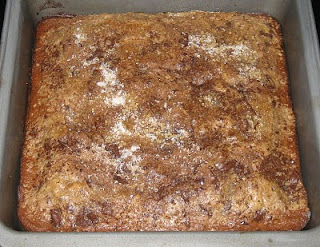I think I may be a convert.
I think I might slowly be turning into an olive person. I don't mean that I have any plans to go out and buy myself a jar to snack on or that now I'm primping my salads with olives or that I have a sudden urge to serve my alcohol with the skewered green ellipsoids, but I have made a discovery.
Scrambled eggs with olive paste.

It is just as good as I thought it would be. Actually I do think this could probably be improved, but I wanted so much to share this with you, I didn't want to bother with a secondary experiment since I don't have the ingredients right now.
So what did I do? I had planned to caramelized some onions and then add some garlic, the Paté di Olive di Gaeta, and some diced tomatoes, but when I went to get onions, they did not look good, and neither did the tomatoes, and I didn't want to use poor quality ingredients, so instead I went with some nice cauliflower.
I cooked the cauliflower in a pat of butter first, to get some color on it, and then I added a tiny bit of minced garlic. I would have added more, but hey, this was like date #15 or something between me and the olive paste, and I like her (of course it's a her, she's complicated, but she just wants to be loved) and so I let her take center stage, hence why I added over ½ tsp of the olive paste (that stuff is strong). Then I cracked in 2 eggs and scrambled!

I don't think I'd entertain with this, because 1) you don't entertain with scrambled eggs and 2) the olive paste does turn the whole thing a weird grey-green color that honestly, I associate with mold (e.g. the kind that grows on spaghetti sauce if you leave it in the fridge for too long), but it did taste good.
The natural sweetness of the cauliflower and the egg goes really well with the olive paste, and the saltiness of the olives means that you really don't need to add more than a very light sprinkling of salt. (I was, of course, very liberal with my black pepper.)
In order to use up some random leftovers (namely, petite peas), and also because I loved cooked eggs where the yolk stay whole and is kind of runny, I made what I call a "fake scramble." This is a technique I've perfected over time, and what it involves is cracking an egg into a hot pan as if you would make it sunny-side up, but then tilting the pan and carefully using a spoon to separate the whites from the yolk. You definitely need a good non-stick skillet for this, to prevent the yolk from getting stuck to the pan and breaking when you're nudging the yolk around and getting it away from the whites.

The reason why I like this is because I love my yolk runny, but I'm not a huge fan of undercooked whites. This techniques allows me to scrambled my whites while cooking my yolk just enough so that it is definitely properly cooked, but still deliciously soupy on the inside (although upon re-reading, "deliciously soupy" doesn't sound as delicious as what I was trying to express). Then I can break my yolk over my scrambled whites and have a delicious meal that is mine all mine.
So for the second scramble, I gently sautéed some petite peas in butter with minced garlic, and then added in one egg. Once my fake scramble was done, I combined a little bit of the scrambled egg #1 mix with the scrambled egg #2 mix, and then I pierced my lovely yolk, and tada! A lovely lunch. Really, you should try it some time. The blanket of creamy yolk over the peas, cauliflowers, and scrambled eggs with olive paste was delicious.

NOTE: For those of you who are so inclined to try this Olive Paste and don't have random friends who bring things back for you from Europe, I can tell you that this would be really easy to make, if you can just get your hands on some good quality black olives. The olive paste is really just olives, specifically Olive di Gaeta (varietà itrana), extra virgin olive oil, and a bit of salt. Get all your ingredients, throw the olives (pitted!) into a food processor, give it a whir, and slowly add in the olive oil till it is the consistency you like. Then salt according to your taste. Easy!































